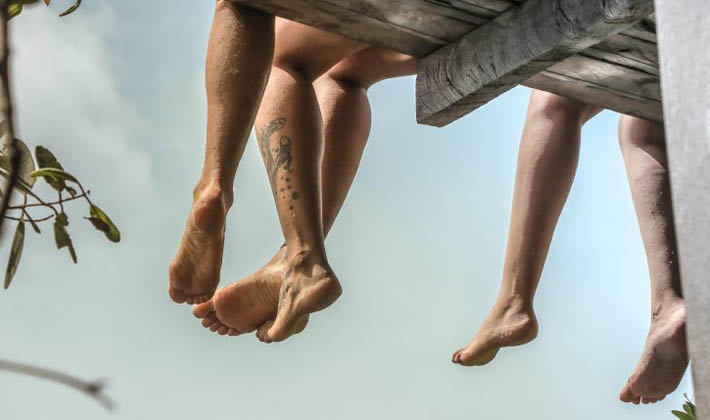Lower limb pain and discomfort is a common concern Pedorthists hear from our patients. Leg pain can come from trauma to soft tissues or bone but also very commonly from overuse. Many jobs have people standing or walking for long periods of time, day after day and week after week. This can lead to pain in your legs and knees.
Below are a few of the common conditions that Canadian Certified Pedorthists treat.
Ankle pain
Ankle pain can be felt on the inside or outside of the ankle depending on the cause or contributing factors. In high arched feet there is often a tendency for the weight to be shifted to the outside of the foot, which stretches the structures on the outside of the ankle and compresses the joint on the inside. High arches can also be prone to lateral ankle sprains.

Flat feet paired with excessive pronation can lead to overstretching of tendons and ligaments on the inside of the ankle, which makes it more difficult for certain muscles to work efficiently and in turn can lead to ankle pain. Creating stability and providing cushioning through orthotics and/or footwear can help you continue on with your day to day activities without ankle pain.
If you have chronically weak ankles due to multiple sprains or you are working or playing on uneven ground, an ankle brace may be a great solution to help keep you feeling comfortable throughout your day.
Shin splints
The shin (or the front part of the leg) contains a few different groupings of muscles. Shin splints typically cause pain on the inside of the lower leg, but pain may also be felt in the muscle groupings on the very front of the shin, or even on the outside. The muscles around the shin attach to different parts of the foot, assisting your foot while you walk. If your feet roll excessively in or out when you walk, the muscles have to work harder to control the motion at your feet. Over time the muscles can be overworked and this leads to pain.
Improper shock absorption in the feet is a frequent cause of shin splints so choosing the correct shoes and providing support to your feet can reduce the strain that is causing the pain. For high arched feet, a neutral cushioning shoe will provide shock absorption and the rocker sole aids in a proper toe off. For flat feet, a stability shoe or motion control shoe gives you a solid base of support and helps to reduce the extra motion occurring at the foot.
Off the shelf and custom-made orthotics are very useful in helping to treat shin splints as they provide the feet with support and help to evenly distribute pressures.
Runners knee
Patellofemoral pain syndrome, often called runners knee, is typically felt as a dull, aching pain in the front of your knee. While active, people often experience the pain during running or jumping sports and you may also experience this pain when walking up or down stairs or after sitting with a bent knee for long periods of time.
To treat runners knee, a multiple treatment approach is usually the best approach. Canadian Certified Pedorthists can help to reduce excess motion in the feet and to increase cushioning through the use of custom-made orthotics and proper footwear. Knee bracing to help stabilize the knee cap and maintain proper knee tracking may also be suggested. Stretching and strengthening of the muscles in your legs is also be a piece of the puzzle.
Osteoarthritis
Osteoarthritis of the knee is a “wear-and-tear” form of arthritis and is the most common form of arthritis seen at the knees. It occurs most frequently in people over the age of 50 but can affect people at an earlier age. Osteoarthritis occurs when the cartilage, the body’s natural cushioning, breaks down and over time the space between the upper leg bone and the lower leg bone is decreased. Common symptoms include stiffness and tenderness around the knee. You may also experience swelling at the knee. Osteoarthritis worsens over time and being aware of it early and taking simple steps can help you function with less pain day to day.
Off the shelf insoles and supportive footwear can make a big difference for those experiencing mild OA of the knee. Bracing that provides stability and even mild compression are also helpful in the early stages. As the condition progresses an offloading brace is recommended in order to transfer the pressure from the side (or compartment) affected by the arthritis. Keeping your body active is important in a person suffering with arthritis so finding ways to make walking or cycling or any movement less painful is imperative.
Canadian Certified Pedorthists are specialized in the assessment for and manufacturing of custom-made orthotics. By completing a thorough assessment of your lower limb range of motion as well as a comprehensive gait analysis, you will learn about your feet and how they work and what is leading to your pain. While custom-made orthotics are an integral part of the treatment plan there are many treatment options that a pedorthist can provide to help with your pain. Footwear, when fit properly and chosen for your foot type and activity, can be a huge part of relieving your pain. Many off the shelf products such as foot compression sleeves, ankle braces or knee braces can help you get through your days with less pain. Canadian Certified Pedorthists will also give suggestions for allied health practitioners that can help to treat your pain.
If you are experiencing pain in your day to day life or pain is limiting you from enjoying certain activities take the right step and contact your local Canadian Certified Pedorthist. You can find one near you be clicking here.
By Jasmine Basner, C. Ped (C)
